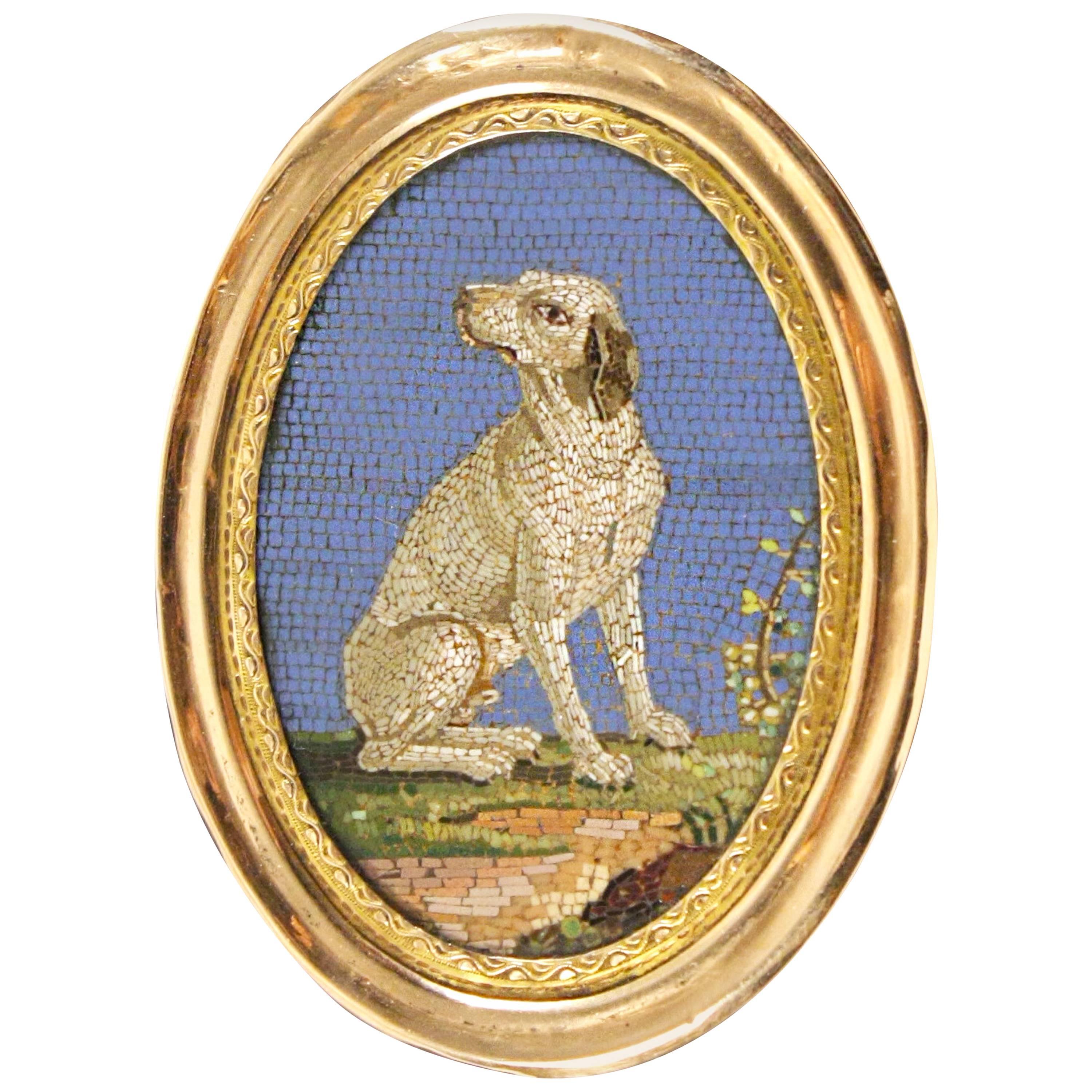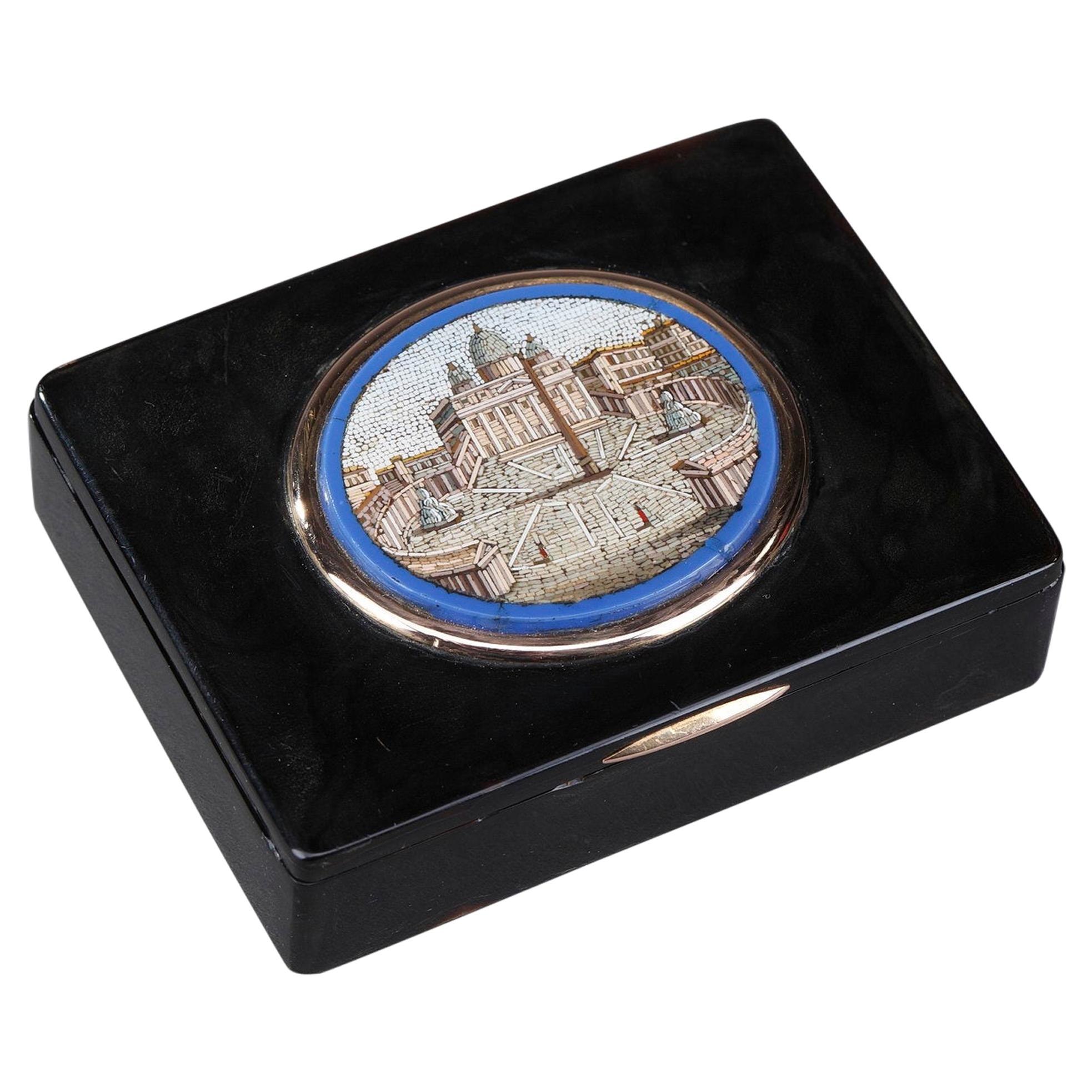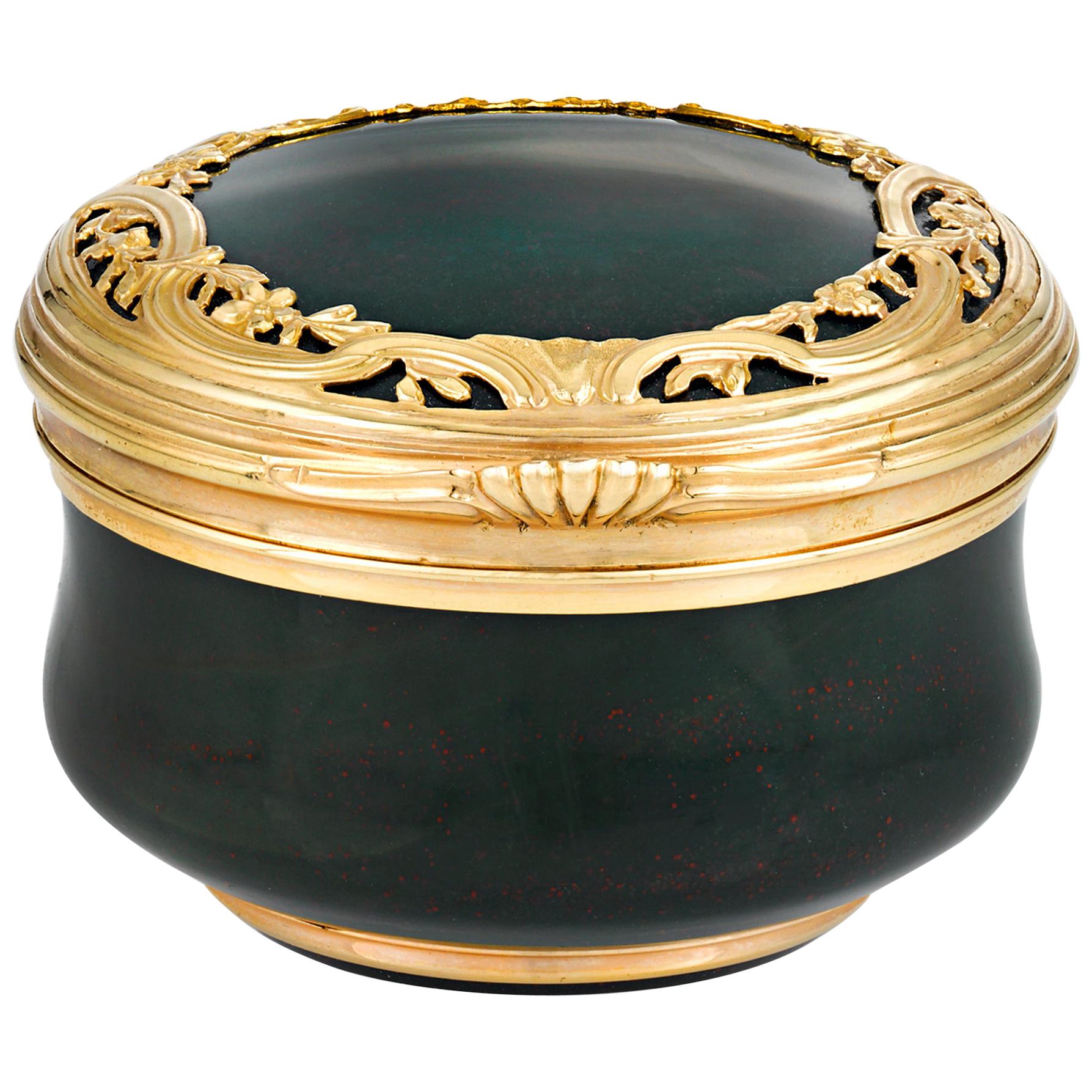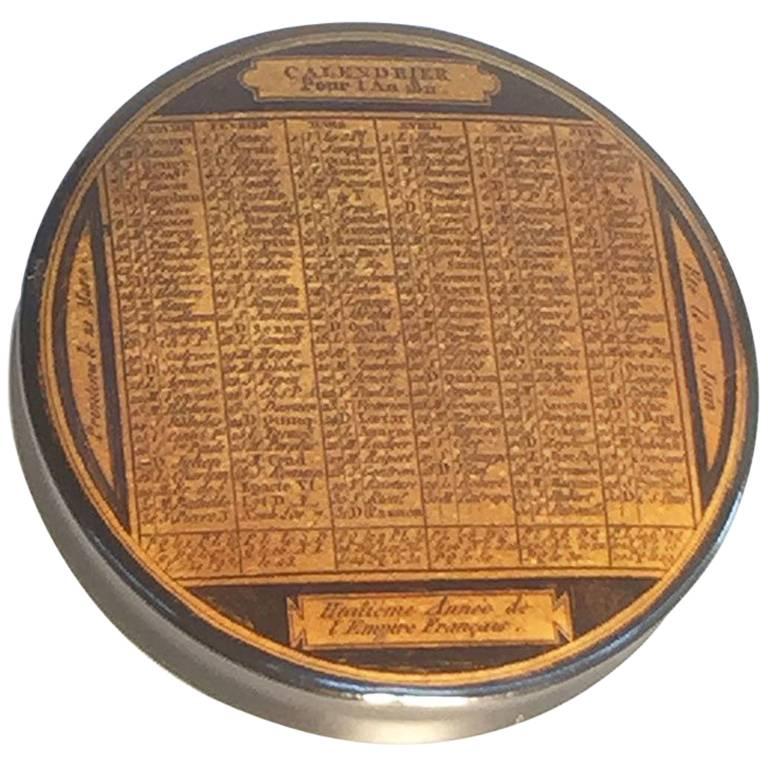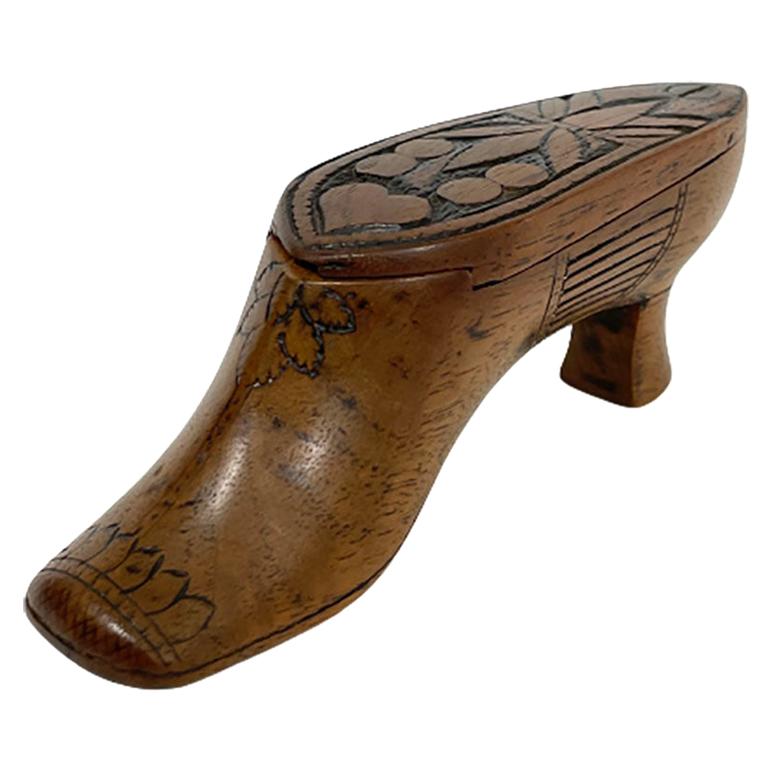Items Similar to Micromosaic Gold Mounted Jasper Snuff Box Early 19th Century Italian Gioacchino
Want more images or videos?
Request additional images or videos from the seller
1 of 11
Micromosaic Gold Mounted Jasper Snuff Box Early 19th Century Italian Gioacchino
About the Item
An Exceptional and Highly Important Micromosaic Gold Mounted Jasper Snuff Box, most probably by Gioacchino Barberi with the box likely by Moulinié, Bautte & Moynier.
Rome & Possibly Geneva circa. 1810
Of green-coloured jasper, mounted in gold, the cover inserted with a micro mosaic panel of the finest quality, worked with a composition of the Capitoline Doves, having a later leather carrying box.
This fine box features a micro mosaic panel of exquisite quality, probably by Gioacchino Barberi of the Barberi workshop in Rome. The panel shows the Capitoline doves, also known as the doves of Pliny. The original Roman mosaic was re-discovered in Hadrian's Villa as part of excavations there in 1737. This is one of the more commonly-encountered panels seen on boxes and other micro mosaic objects but there are several aspects to our panel that make it very rare indeed. As pointed out in Micromosaics: The Gilbert Collection, a summary of the pre-eminent Rosalinde and Sir Arthur Gilbert collection of such pieces currently housed in the Victoria and Albert Museum, it is very rare to find a micro mosaic of this subject that features the reflection of the central dove drinking from the water. Sir Arthur had six versions of this panel mounted on boxes in his collection and even with his exacting standards, only three of these pieces feature the reflection. When looking at micro mosaics in collections more generally, those without Sir Arthur's enormous bank balance behind them, the contrast in numbers is much more marked. Most of the examples that do show the dove's reflection fail to show the ripples in the water caused by the dove's beak breaking the surface and again this fine detail is present in our piece.
A comparison with this box in the Gilbert collection is instructive.
It is always difficult to reproduce curves effectively in this medium and the box in the Gilbert collection is much more blocky-see for example the execution of the mouldings on the base of the bowl from which the doves drink. The Gilbert box features silver gilt mounts and an opaque glass body whereas our piece features gold mounts and a jasper body, further proof that our piece was destined for a truly elite client as the price would have been extremely steep indeed when new.
The Attribution to the Barberi Workshop
Several members of the Barberi family in Rome were involved in the production of micro mosaics. Michaelangelo Barberi seems to have concentrated on large tops produced for furnishing purposes, particularly table tops, but his uncle Gioacchino Leone Ulisse (1782-1857) is recorded as a leading producer of miniature micro mosaic items. The Barberis enjoyed the patronage of an elite clientele of tourists and native consumers, clients including Emperor Napoleon III and countless members of Britain's aristocracy throughout the 19th century. A rare example of a table top made by Gioacchino Barberi was sold at Sotheby's New York 12 April 2011, lot 254. The piece was originally made for Prince Anatole Demidoff.
Gioacchino's workshop was located at 99 Piazza di Spagna and he is believed to have pioneered the use of black enamel smalti, utilised by his firm when reproducing wall paintings from Herculaneum in the micro mosaic technique. A very fine animal subject snuff box by Barberi is illustrated in Jeanette Gabriel, The Gilbert Collection, Micromosaics, 2000, cat. 18. This piece was mounted in a box by A. J. Strachan of London and hallmarked for 1807-1808.
Barberi is known to have entered in to a partnership with the Geneva-based firm of box makers Moulinié, Bautte and Moynier and a small number of boxes by the firm with Barberi micro mosaic plaques survive (see for example one which sold at Sotheby’s London, 10 May 2016, lot 254). Given the outstanding quality of our piece, it is likely to have been one of the joint productions of these two wonderful firms of artisans
- Dimensions:Height: 0.99 in (2.5 cm)Width: 3.35 in (8.5 cm)Depth: 2.56 in (6.5 cm)
- Materials and Techniques:
- Place of Origin:
- Period:
- Date of Manufacture:circa. 1810
- Condition:Wear consistent with age and use. A later leather carrying box.
- Seller Location:Benington, GB
- Reference Number:
About the Seller
5.0
Gold Seller
These expertly vetted sellers are highly rated and consistently exceed customer expectations.
Established in 1969
1stDibs seller since 2015
112 sales on 1stDibs
Typical response time: <1 hour
Associations
LAPADA - The Association of Arts & Antiques DealersThe British Antique Dealers' Association
- ShippingRetrieving quote...Ships From: Benington, United Kingdom
- Return PolicyA return for this item may be initiated within 3 days of delivery.
More From This SellerView All
- Late 17th Century Leather And Brass Travelling BoxLocated in Benington, HertsA very fine and interesting late 17th century English work box or travelling case English Circa 1680 Of conventional form with slightly domed lid, this piece has acquired a magnifi...Category
Antique 1680s English Decorative Boxes
MaterialsBrass
- 18th Century Georgian Paper Scrolled Quilled Satinwood Tea CaddyLocated in Benington, HertsA wonderful 18th century George III quill work (scrollwork) tea caddy of hexagon form. English circa 1790 Finely executed, this very attractive caddy ...Category
Antique 1790s British Georgian Tea Caddies
MaterialsSatinwood
- French Thuya And Brass Inlaid Serpentine Cave A Liqueur Or Tantalus BoxLocated in Benington, HertsAn Exceptionally Fine French Serpentine and brass marquetry inlaid Cave a Liqueur or Tantalus Box with mother of pearl. French circa 1870 Primarily veneered in fine thuya wood of...Category
Antique Late 19th Century French Decorative Boxes
MaterialsSerpentine, Brass
- Extremely Rare Pair of Regency Cast-Iron Sarcophagus Shaped Strong BoxesLocated in Benington, HertsAn extremely rare pair of Regency cast-iron sarcophagus shaped strong boxes. Regency, circa 1820 Painted to simulate palisander wood and with parcel-gilt, the cavetto-moulded hinged lids cast with flower sprays above foliate-cast bands over front panels relieved with river gods within canted corners cast with standing muses, the sides with lion mask and ring handles over leafy aprons on massive lion’s paw feet; the Brahmah type lock stamped “T. Davis from London” and impressed with the Royal Crown. These extraordinary pieces are modelled on Regency wine coolers. The forms are classic Greco-Roman revival with the boat-hook handles, mythic figures and the overall sarcophagus pattern. You would struggle to find one let alone a pair. Good items for any collection. Research on going into these strong boxes but we have found possible information on the lock stamped Davis….(historyoflocks ) The relationship of King George III and George Davis of Windsor, who was locksmith in ordinary to His Majesty. Davis, in 1799, invented and patented a unique style of lock, which was also beautifully engraved with a warning not to make duplicate keys. Sensitive government secrets always demanded, then as today, locks that were state of the art. Davis locks ended up on government dispatch boxes...Category
Antique Early 19th Century English Regency Commodes and Chests of Drawers
MaterialsIron
- Pair of 19th Century Gilt Bronze-Mounted Moroccan Leathered ArmchairsBy Maison LalandeLocated in Benington, HertsA very fine pair of late 19th century French Empire style mahogany library bergeres, gilt bronze mounted retaining the original Moroccan leather upholstery, attributed to Maison Lala...Category
Antique 19th Century French Armchairs
MaterialsBronze
- Fine 19th Century Italian Venetian Carved Giltwood ArmchairLocated in Benington, HertsFinely carved mid 19th century Italian giltwood open armchair of wide proportions in the Rococo manner. Italy, Venice Circa 1860. The asymmetrical scroll and leaf-carved top rail, centred on a stylised shell within over scrolled uprights, above a newly upholstered grey silk padded and dished seat between scroll-ended arms, raised on a decorative foliate carved scrolling X-frame base with a conforming central stylised shell. In excellent condition having a wonderful look to the gilt work this gondola style chair...Category
Antique 19th Century Italian Rococo Armchairs
MaterialsSilk, Giltwood
You May Also Like
- Italian Gold-Mounted Micromosaic Snuff BoxLocated in New York, NYItalian micro mosaic plaque mounted within snuff box, depicting white and brown hound seated on grass. Circle of Giacomo Raffaelli (1753-1836). R...Category
Antique Early 19th Century Italian Snuff Boxes and Tobacco Boxes
MaterialsGlass
- 19th Century Restauration Snuff Box with MicromosaicLocated in Paris, FRSmall rectangular Restauration snuff box crafted in gold. The hinged lid is decorated with an oval micromosaic representing St. Peter's Square in Rome. Micromosaic is set in a gold s...Category
Antique Early 19th Century French Charles X Tobacco Accessories
MaterialsGold
- 18th-Century Green Jasper Snuff BoxLocated in New Orleans, LAMounted in delicate 18K yellow gold openwork is this exquisite 18th-century English snuff box formed from green jasper. For over 300 years, master artisan...Category
Antique 18th Century English Georgian Snuff Boxes and Tobacco Boxes
MaterialsStone, Gold
- Empire French Pressed Wood Snuff Box, Early 19th CenturyLocated in Spencertown, NYThe circular lidded box depicting a woman reclining on a Recamier playing the harp. The underside with a star surrounded by banding with stippling decoration.Category
Antique Early 19th Century French Empire Snuff Boxes and Tobacco Boxes
MaterialsWood
- French early 19th Century lacquered papier mâché snuff boxBy StobwasserLocated in Delft, NLFrench early 19th Century lacquered papier mâché snuff box Lacquered Papier Mâché Snuff Box, Calendar 1811, Names of All Saints Per Day. Frenc...Category
Antique 19th Century French Snuff Boxes and Tobacco Boxes
MaterialsPaper
- Dutch Early 19th Century Wooden Shoe Shaped Snuff BoxLocated in Delft, NLDutch early 19th century wooden shoe shaped snuff box An early 19th century wooden hand carved snuff box The lid slides open and closed over the top. Measures 4 cm high, 12 cm...Category
Antique Early 19th Century Dutch Snuff Boxes and Tobacco Boxes
MaterialsWood
Recently Viewed
View AllMore Ways To Browse
Vintage Snuff Jar
Vintage Snuff Jars
Dog Tie Bar
Bolt Cigarette Box
Cigar Holder Music Box
Sniff Pill Box
Golden Turtle Box
Vintage Snuff Tin
Vintage Snuff Tins
Used Aristocrat Humidor
Vintage Pop Up Cigarette Dispenser
Vintage Snuff Box Snuff Boxes
Vintage Snuff Boxes Snuff Boxes
Vintage Snuff Snuff Boxes
Vintage Snuff Boxes And Tobacco Boxes
Rectangular Snuff Boxes
Small Snuff Boxes
Chinese Game Box
